The 'Hands Off' demonstrations currently affecting the United States have triggered widespread dialogue about major social and political issues.
The movement began from public dissatisfaction with government policies but has produced impacts that extend beyond political debate to affect national economic conditions and investors' perspectives. Investors need to grasp the market effects of large-scale demonstrations to maintain a competitive edge.
The 'Hands Off' protests represent social unrest that can interrupt industry operations while changing market behavior and posing difficulties for conventional investment approaches. The article examines the economic impacts of protests, reveals affected industry sectors, and suggests strategic portfolio adjustments for investors to manage risks and identify opportunities.
Understanding the 'Hands Off' Protests
The 'Hands Off' protests arise from resistance to government policy changes that protesters see as threats to both civil rights and economic justice. The protests have evolved into a multi-city movement which includes demonstrations and online campaigns. The demonstrators have effectively extended their message to shape public opinion while drawing policymakers' focus.
Markets tend to be affected when social movements reach these levels of impact. The emergence of social unrest leads to changes in consumer demand patterns while disrupting business operations and causing shifts in consumer priorities. Monitoring public sentiment is crucial for investors because it delivers advanced warnings about potential market changes alongside financial indicators.
Economic Consequences of the Protests
Economic activity faced disruptions at both local and national levels due to the 'Hands Off' protests. The protests have led to immediate economic disruptions, which include halted supply chains and business shutdowns in affected locations, together with reduced productivity because of street blockades and worker absences.
Long-term impacts, however, could be more significant. Consumer confidence-dependent industries like retail and tourism experience increased vulnerability during unrest periods. Consumer behavior trends may push customers towards online shopping platforms as brick-and-mortar stores in cities experiencing protests could experience decreased customer visits.
Heavy protest activity in regions can cause economic growth to slow down because investors pull back and business reputations suffer.
Which Sectors are Most Impacted?
- Retail: Protest-affected regions see physical stores experience both supply delays and property destruction. Online retailers, however, could be more insulated.
- Transportation and Logistics: Urban-based companies may experience operational difficulties as road blockages lead to shipment delays.
- Tourism and Hospitality: The tourism and hospitality sector suffers significant financial harm when travel plans are canceled and tourism declines, especially in cities that regularly experience protests, which garner media attention.
- Technology and Media: Businesses that enhance their safety protocols or social media moderation services may experience increasing demand because society is paying more attention to their platforms.
Shifts in Investor Sentiment
When social unrest continues for an extended period investors respond by increasing market volatility because they perceive higher levels of risk. Political instability leads investors to seek stability by moving their funds to safe investment options like treasury bonds, utility stocks and gold.
During periods of high risk, investor activity tends to slow in sectors like consumer goods and real estate because people try to prevent financial losses. Political and social instability often triggers market corrections which create additional complexity for investment decisions.
Strategic Investment Adjustments During Social Unrest
Investors must adopt a diversified investment strategy to manage the market uncertainty caused by the 'Hands Off' protests. Here are actionable strategies to consider:
1. Diversify Your Portfolio
Avoid overexposure to volatile sectors. Investing in a diversified portfolio that includes assets from stable industries helps maintain stability amid civil unrest.
2. Seek Defensive Sectors
Industries that provide essential services like utilities and healthcare tend to maintain stability through periods of unrest. By directing investments into these sectors, you can reduce overall risk exposure.
3. Evaluate Safe-Haven Assets
During times of social instability, people often turn to gold, government bonds and cash equivalents because they are considered to be safer investments. Investing some of your portfolio in these types of assets can protect your wealth while markets regain stability.
4. Explore Emerging Opportunities
Some industries experience growth even throughout periods of protest. Technology sectors focused on safety and community-building may receive increased attention and financial support. Renewable energy stands to gain from the policy changes that result from ongoing protests.
Monitoring Future Protests and Policy Impacts
Investors need to monitor the progression and strength of the 'Hands Off' protests constantly. The frequency of demonstrations, along with government reactions and emerging public policies, serves as an indicator for predicting future market responses.
Investors who track regions or industries with consistent disruptions can make better investment choices. Government responses to protest demands could introduce new risks or opportunities through policy changes in taxation or labour rights.

















